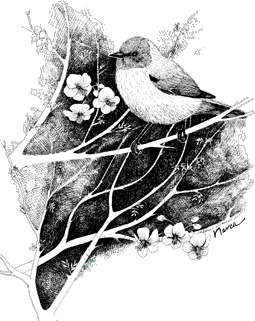Verdin
Tiny and rather plain, the Verdin seems quite unremarkable at first sight. But it is among the most characteristic birds of the desert, and it has one notable distinction: it is not closely related to any other bird in the western hemisphere. For a while it was placed, uneasily, in the same family as the chickadees, which it resembles in size and in hyperactive behavior. Scientists now believe that its closest relatives are several species of small, plain birds found in Europe, Asia, and Africa.
 Verdins
seem undaunted by our extremes of weather. Hardy and adaptable, they are
active on the hottest days and the coldest winter mornings. Although they
are most common in thick mesquite bosques, they also range out onto open
flats where the plant life is sparse, and they readily move into desert
cities. Insects are their main menu items, but Verdins also take nectar;
among desert birds, they are second only to the hummingbirds as flower
visitors, and they also come to hummingbird feeders to sip sugar water.
Verdins
seem undaunted by our extremes of weather. Hardy and adaptable, they are
active on the hottest days and the coldest winter mornings. Although they
are most common in thick mesquite bosques, they also range out onto open
flats where the plant life is sparse, and they readily move into desert
cities. Insects are their main menu items, but Verdins also take nectar;
among desert birds, they are second only to the hummingbirds as flower
visitors, and they also come to hummingbird feeders to sip sugar water.
Except when they pair up for nesting, Verdins generally go their own way as individuals. Their nests are surprisingly large for the size of the bird; they are hollow globular masses of thorny twigs, each with an entrance low on one side. Since these birds build nests in which to sleep at night, as well as those for raising young, the nests are often easier to find than the Verdins themselves.
-Kenn KaufmanVerdin (Auriparus flaviceps)
Order: Passeriformes
Family: Remizidae (Verdin and related birds)
Spanish name: verdín
Distinguishing features
A small bird with gray back, white underparts, a yellow head and throat, and a red-chestnut patch at the bend of the wings. Immatures lack both the yellow and chestnut coloration of adults. This bird is easily recognized by its rather loud, rapid whistle.
Habitat
Most common in the Sonoran Desert and mesquite bosques at lower elevations;
also common in many southwestern urban areas.
Feeding
- Diet: Mainly insects.
- Behavior: Verdins move and behave much like chickadees, flitting about
singly or in pairs in search of food, often hanging upsides down to
reach the underside of leaves. They are generally tolerant of people
except during the nesting season. The diet consists mainly of insects
but small spiders, berries, small fruits, and sometimes seeds are also
taken. This bird also drinks nectar and sugar water, as people that
have hummingbird feeders hung out know all too well.
Life History
The male may build several bulky twig nests before the female chooses one in which to lay her 3 to 6 pale green, red-brown dotted eggs. These large oval or spherical nests are placed rather far out on branches and may last many years in the dry desert environment. The entrance to the nest often faces prevailing winds, possibly an adaptation to the high temperatures of their desert habitat. Incubation takes about 10 days and the young are ready to leave the nest about 21 days after hatching, although they return to the nest at night.
Color in Birds
The color of feathers is either due to pigments deposited within the feather during growth or to structures within the feather that manipulate light; or color may be due to a combination of these two. Three common pigment types are melanins (browns, blacks, some yellows), carotenoids (some reds and yellows), and porphyrins (some reds or browns). Structural colors include blue and iridescence. Greens and violets are combinations of a pigment with a structural manipulation of light.
The functions of color in birds can generally be divided into those that will help conceal a bird (cryptic colors) or colors that will make the bird more conspicuous (phaneric colors). Patterns result in camouflage, counter shading, flash patterns, display plumages, and sexually dimorphic plumages.